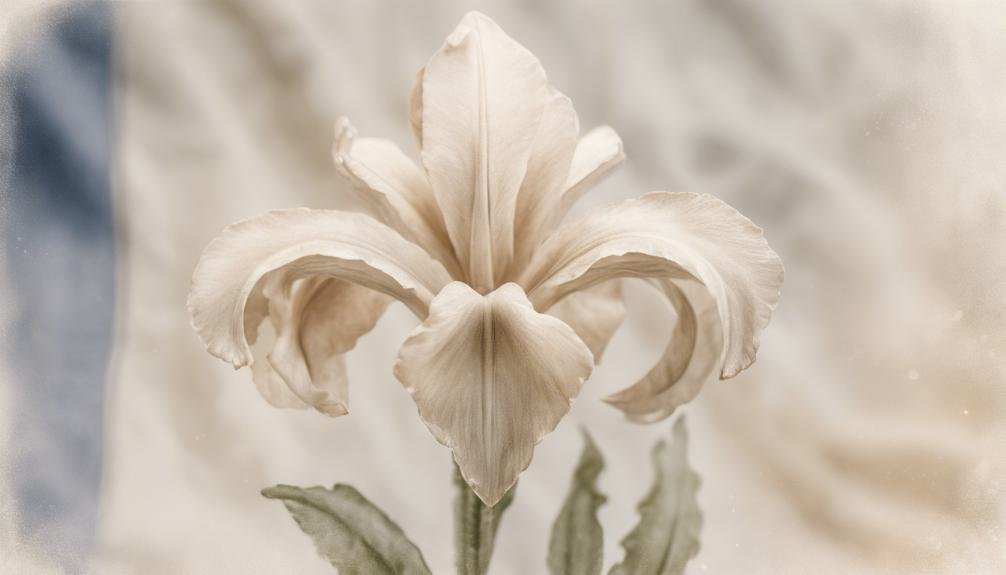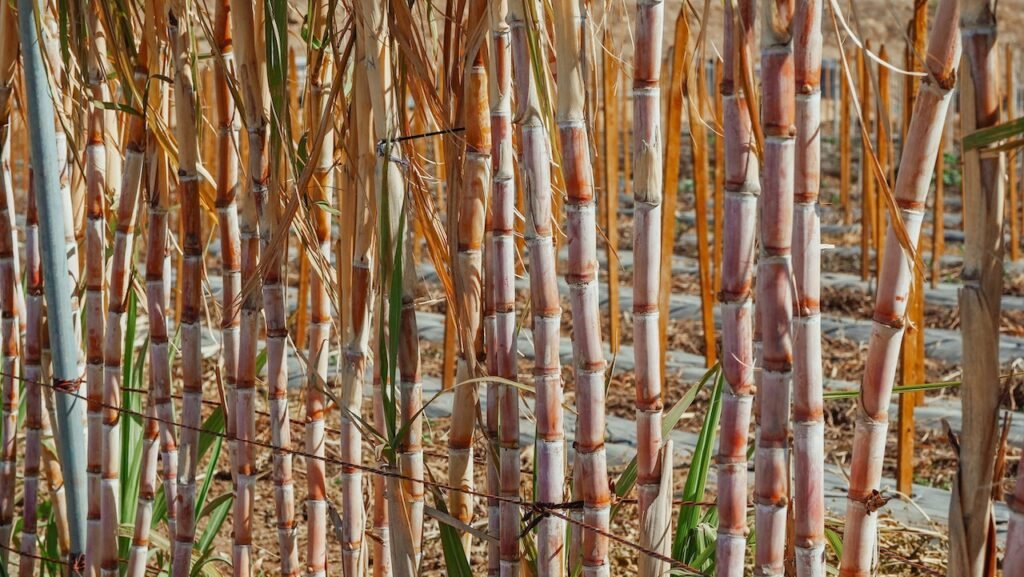You’re likely familiar with France’s grandeur, and maybe you’ve wondered what symbolizes the essence of this majestic nation – it’s the fleur-de-lis and the iris, which together form the national flower of France. The fleur-de-lis dates back to the 12th century, initially associated with French monarchs, symbolizing purity and royalty. The iris, with its majestic petals and striking colors, represents faith, hope, and wisdom. As you explore France’s national identity, you’ll uncover the intricate history and cultural significance behind this emblematic flower, and discover more about the country’s complex heritage and artistic expression.
Key Takeaways
- The fleur-de-lis is the national symbol of France, representing purity, nobility, and perfection.
- The iris is the national flower of France, symbolizing faith, hope, and wisdom in the language of flowers.
- The fleur-de-lis has been a recurring motif throughout France’s past, representing purity, innocence, and refined beauty.
- France’s national identity is deeply rooted in the fleur-de-lis and iris, reflecting the country’s esteemed values of elegance and sophistication.
- The iris is a popular symbol in French culture, often featured in art, literature, and festivals, showcasing the country’s rich heritage.
History Behind the Symbol

The fleur-de-lis, a symbol dating back to the 12th century, played a significant role in the evolution of France’s national identity.
Initially associated with French monarchs, the fleur-de-lis symbolized purity and royalty. During the Middle Ages, it became a powerful tool for floral diplomacy, facilitating relationships between European royal families.
However, with the onset of the French Revolution, the fleur-de-lis underwent a transformation, shedding its aristocratic connotations to become a symbol of national unity and resistance. This shift marked the beginning of its Revolutionary roots, as the fleur-de-lis became a potent emblem of the people’s struggle for freedom and equality.
Throughout the 19th and 20th centuries, the fleur-de-lis continued to evolve, assuming various meanings depending on the political context. Today, it remains an integral part of France’s national identity, reflecting the country’s complex history and cultural heritage.
Meet the National Flower
France’s national flower, the iris, is a majestic bloom that has been intertwined with the country’s history and culture for centuries.
As you explore further into the world of irises, you’ll discover that this flower is more than just a beautiful bloom. Did you know that the iris has a rich history of symbolism? In the language of flowers, the iris represents faith, hope, and wisdom. Its majestic petals, shaped like a sword, symbolize the connection between heaven and earth.
When you examine the iris closely, you’ll notice its unique petal shape. The iris has three petals that droop downwards, while the three upper petals stand upright, forming a striking contrast.
This unique shape has led botanists to classify the iris as a member of the Iridaceae family. The iris’s striking colors, ranging from purple to white, add to its allure.
As you venture into the world of irises, you’ll realize that this flower isn’t only a symbol of French culture but also a masterpiece of nature’s design.
Cultural Significance Unraveled

As you explore the iris’s symbolism further, you’ll find that its cultural significance extends beyond its beauty, with the flower playing a prominent role in French art, literature, and heraldry throughout history. The iris has been a recurring motif in French art, often symbolizing faith, hope, and wisdom. In literature, the iris has been used as a metaphor for nobility, elegance, and refinement.
| Art Movement | Iris Depiction | Symbolism |
|---|---|---|
| Impressionism | Soft, dreamy petals | Fleeting beauty, impermanence |
| Renaissance Art | Regal, majestic blooms | Royalty, power, nobility |
| Art Nouveau | Intricate, stylized designs | Luxury, elegance, refinement |
| Romanticism | Whimsical, fantastical scenes | Emotions, passion, love |
| Modern Art | Abstract, bold forms | Freedom, creativity, innovation |
As a floral emblem, the iris has become an integral part of French cultural identity, representing the country’s rich heritage and artistic expression. It’s no wonder that the iris has been adopted as a cultural icon, symbolizing the essence of French culture and history.
Symbolism in French Heritage
As you examine the symbolism in French heritage, you’ll notice that the country’s cultural significance is deeply rooted in its history.
You’ll find that the fleurs-de-lis, a stylized lily flower, has been a recurring motif throughout France’s past, representing purity, nobility, and perfection.
French Cultural Significance
You’ll discover that the fleur-de-lis, a stylized lily, is deeply ingrained in French heritage, symbolizing purity, innocence, and refined beauty.
This symbolic representation is intricately tied to French identity, reflecting the country’s rich cultural fusion.
The fleur-de-lis has been a recurring motif in French art, architecture, and literature, solidifying its position as an emblem of French culture.
In the sphere of French cultural significance, the fleur-de-lis embodies the nation’s historical and artistic heritage.
It represents the country’s esteemed values, such as elegance, sophistication, and refinement.
The stylized lily has also been adopted by various French institutions, including the country’s coat of arms, further emphasizing its importance in French identity.
As you explore further into French culture, you’ll find that the fleur-de-lis is an omnipresent symbol, transcending time and artistic mediums.
From medieval tapestries to modern-day fashion, the fleur-de-lis continues to inspire and influence French artistry, reinforcing its status as a timeless and enduring symbol of French cultural significance.
Historic Fleurs-de-lis Roots
As you plunge into the history of France’s national flower, you’ll discover that France’s rich cultural heritage is rooted in the fleur-de-lis’s symbolic significance, which dates back to the medieval period when it emerged as a powerful emblem of French monarchy and nobility.
This regal flower was often depicted in medieval ornateness, adorned with intricate designs and patterns, reflecting the era’s grandeur and opulence.
The fleur-de-lis’s significance can be attributed to three key factors:
Royal patronage: The flower was favored by French monarchs, who used it to symbolize their power and authority.
Medieval ornateness: The fleur-de-lis was often incorporated into elaborate designs, showcasing the era’s artistic and cultural achievements.
Noble lineage: The flower was associated with nobility, representing purity, honor, and virtue.
As you explore the fleur-de-lis’s historic roots, you’ll understand how it has become an integral part of French heritage, symbolizing the country’s rich cultural and historical legacy.
Where to Find It Growing

As you explore the French countryside, you’ll find the national flower thriving in its natural habitats.
You can also visit regional garden centers, which often cultivate and display this iconic bloom.
French Countryside Blooms
In the picturesque regions of Provence and Normandy, the French countryside bursts with vibrant blooms of lavender, sunflowers, and cornflowers, which thrive in the fertile soil and mild climate. As you explore the rural landscapes, you’ll notice that these flowers aren’t only aesthetically pleasing but also play a pivotal role in the ecosystem.
You can find these blooms in:
Village gardens, where locals carefully tend to them, ensuring their beauty and fragrance are showcased to perfection.
Wildflower meadows, where they grow freely, attracting pollinators and adding to the region’s biodiversity.
Farm fields, where they’re often used as companion plants, providing natural pest control and improving soil health.
When visiting these areas, take note of the specific conditions that allow these flowers to flourish. Observe how the soil composition, sunlight, and water availability all contribute to their growth. By understanding these factors, you’ll gain a deeper appreciation for the science behind the beauty of the French countryside.
Regional Garden Centers
Regional garden centers in Provence and Normandy feature local nurseries and botanical gardens that cultivate and showcase the iconic flowers of the French countryside, offering a unique opportunity to observe and learn about these blooms up close.
These centers provide a platform for botanists, horticulturists, and enthusiasts to explore the diverse range of flora, including the national flower of France.
By participating in guided Garden Tours, you’ll gain insight into the cultivation and maintenance of these delicate flowers, as well as their role in the region’s ecosystem.
At local nurseries, you’ll have the chance to interact with experts who can share their knowledge on the specific growing conditions, soil requirements, and pruning techniques necessary for ideal bloom production.
Many of these nurseries also offer workshops and educational programs, providing hands-on experience in flower arrangement, propagation, and conservation.
Fun Facts and Trivia
Three centuries ago, the fleur-de-lis, symbolizing French nobility and royalty, became a widespread national emblem, later influencing the country’s choice of national flower.
You might be surprised to learn that the lily, also known as the ‘fleur-de-lis,’ has been a prominent symbol in French botany for centuries. In fact, it’s not uncommon to find lilies featured prominently in French flower festivals, where they’re often paired with other flowers like lavender and sunflowers.
Lily species: There are over 90 species of lilies, ranging in color from pure white to vibrant pink and yellow.
Cultural significance: In French culture, lilies symbolize purity, innocence, and refined beauty.
Fragrance: Many lily species are known for their intense, sweet fragrance, which is often used in perfumes and fragrances.
As you explore the world of French botany, you’ll likely come across the lily again and again. Whether it’s at a flower festival or in a quiet garden, the lily is an iconic symbol of French culture and beauty.
Frequently Asked Questions
Is the National Flower of France Also a National Symbol of Another Country?
As you explore into the world of national emblems, you’ll find that some flowers hold cultural significance and historical importance beyond their native borders, raising the question: can a national flower symbolize multiple nations, and what does that imply about shared heritage?
Can I Grow the French National Flower in My Backyard Garden?
You can grow the Lily, a temperamental beauty, in your backyard garden if you meet its specific soil requirements, tolerate its limited climate tolerance, and provide precise care, ensuring ideal growing conditions.
Is the National Flower of France Used in Any Traditional Medicine?
You’ll find that certain botanicals, like the one in question, are integral to French herbalism, featuring in ancient remedies for their medicinal properties, which are still utilized today in modern pharmacopeia and holistic treatments.
Are There Any Festivals Dedicated to the French National Flower?
You’re wondering if there are festivals dedicated to a certain bloom, and the answer is yes! The Fleur festival has a rich history, while the Lily of love celebrations honor the flower’s symbolic significance in French culture.
Can I Use the French National Flower as a Wedding Bouquet Decoration?
When selecting wedding bouquet decorations, you’ll want to ponder using flowers that exude French romance and wedding elegance. The fleur-de-lis, with its delicate petals and symbolic significance, can add a touch of sophistication to your arrangements.


